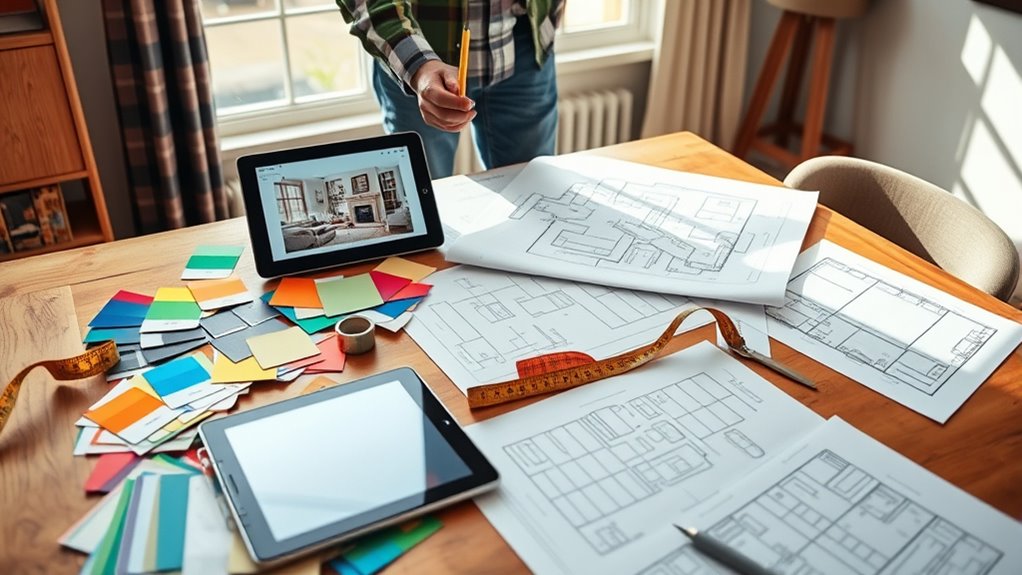To begin planning your home project, start by clarifying your goals so you know what you want to achieve. Set a realistic budget and gather inspiration from sources like magazines or social media to develop a clear vision. Create a detailed timeline and select the right materials and tools. Consider hiring trusted professionals and preparing your space before work starts. Keep track of progress and stay flexible. If you keep exploring, you’ll find ways to make your project a success from start to finish.
Key Takeaways
- Define clear goals and priorities to guide your project and stay focused on essential tasks.
- Establish a realistic budget, including contingency funds, and track expenses throughout the process.
- Research inspiration sources and create a detailed plan with milestones and deadlines.
- Hire qualified professionals and prepare the space by clearing and protecting areas before construction begins.
- Monitor progress regularly, remain flexible for unexpected changes, and celebrate completed milestones.
Clarify Your Home Project Goals
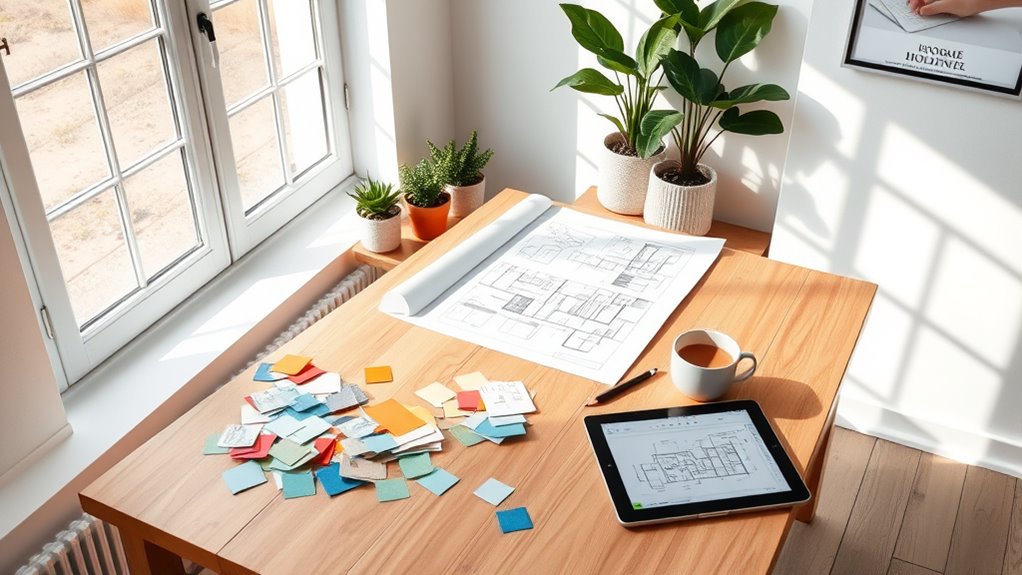
Have you clearly defined what you want to achieve with your home project? It’s the first step to a successful plan. Start by defining your objectives—what’s the main purpose of this project? Are you increasing space, updating style, or improving functionality? Once you’ve identified your objectives, set priorities to determine what’s most important. Focus on essential upgrades first and consider how each task aligns with your overall goals. Clarifying your goals helps you stay focused and avoid unnecessary work. It also guides decision-making, ensuring every step moves you closer to your desired outcome. Remember, clear objectives and priorities keep you organized and motivated throughout your project. Incorporating proper safety measures, such as inspecting electrical components and following manufacturer guidelines, can help prevent hazards during your home upgrades. This foundation makes the entire planning process smoother and more effective.
Establish a Realistic Budget
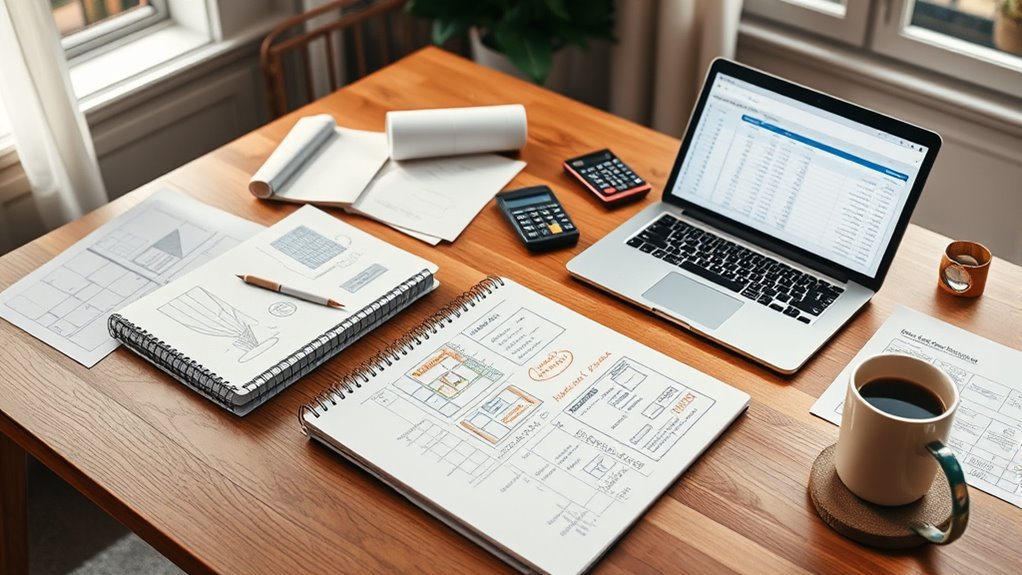
Setting a realistic budget is essential to keep your home project on track and avoid unexpected expenses. Start by estimating material costs accurately, researching prices, and including a buffer for price fluctuations. Don’t forget to allocate contingency funds—usually around 10-20% of your total budget—to cover unforeseen issues or changes. Be honest about what you can afford and prioritize spending on essentials, avoiding overspending on less critical details. Track your expenses regularly to ensure you stay within your limits. Remember, having a well-planned budget helps prevent delays and keeps your project moving forward smoothly. By setting clear financial boundaries early, you’ll create a solid foundation for a successful home project. Gold investments can also serve as a form of diversification in your overall financial planning.
Research and Gather Inspiration

Where do you start when looking for ideas to transform your home? Begin by browsing home decor magazines, websites, or social media platforms like Pinterest and Instagram. Collect images that catch your eye, focusing on styles and color schemes you love. Take note of details that appeal to you, such as furniture, lighting, or wall art. Visiting showrooms or home decor stores can also spark ideas and help you see how different elements work together. Don’t rush this process—gather inspiration from various sources to understand your preferences and establish a cohesive vision. This step helps you define your style and creates a foundation for your project, making it easier to make decisions later. Exploring design trends and incorporating your unique preferences will ensure your project feels personalized and timeless.
Create a Detailed Plan and Timeline
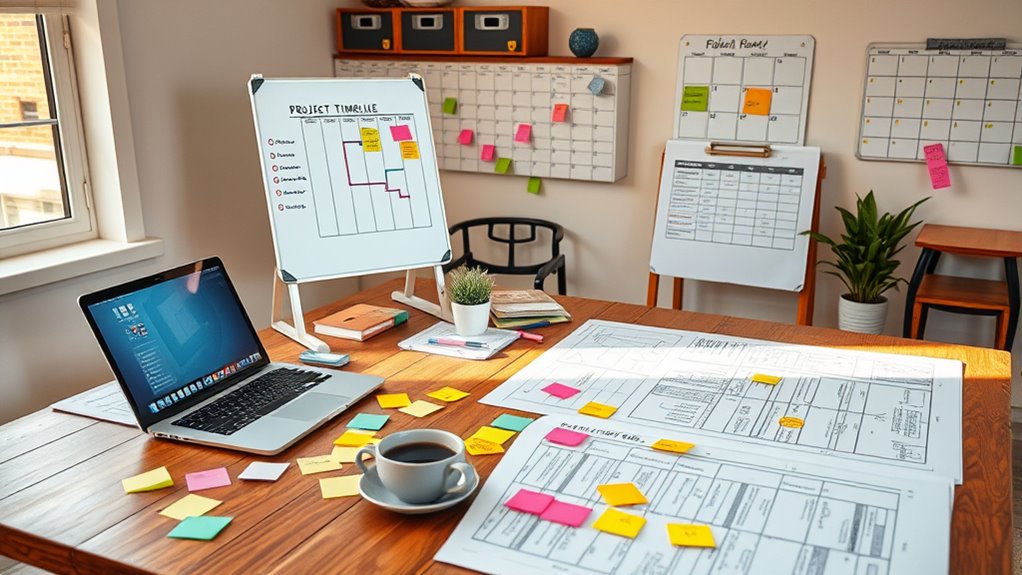
Once you’ve gathered your inspiration, the next step is to create a detailed plan and timeline to keep your project organized and on track. Break down the project into clear milestones, such as design completion, material procurement, and construction phases. These project milestones help you measure progress and stay motivated. Be realistic about timeframes, and include buffer periods for unexpected delays. Contingency planning is essential—anticipate potential issues like supplier delays or unforeseen repairs, and develop backup solutions. Using a calendar or project management tool, assign deadlines to each milestone, ensuring everything aligns with your overall schedule. Incorporating regular assessments can help you stay on top of each phase and adapt as needed. This structured approach minimizes stress, keeps you focused, and makes your home project feel manageable from start to finish.
Select the Right Materials and Tools

You need to choose materials that will last and suit your project’s needs, so consider their durability and quality. Picking the right tools guarantees the job gets done efficiently and safely. Keep your budget and material availability in mind to avoid delays or overspending. Additionally, understanding the shelf life of materials can help you select options that maintain their integrity throughout your project.
Assess Material Durability
Choosing the right materials and tools is essential to guarantee your project’s durability. To do this, you need to assess each material’s durability by considering its material lifespan and wear resistance. Material lifespan indicates how long the material will last under normal use, while wear resistance shows how well it withstands friction, scratches, and daily stress. For example, if you’re selecting flooring, opt for options with high wear resistance to prevent early damage. When evaluating options, look for product specifications and reviews that highlight durability qualities. Additionally, understanding the specific requirements for performance upgrades can help select materials that withstand increased stress levels. Remember, investing in durable materials might cost more upfront but saves you money and effort in repairs and replacements down the line. Making informed choices based on durability ensures your project stands strong over time.
Choose Suitable Tools
Selecting the right tools is essential for ensuring your home project proceeds smoothly and safely. You’ll want dependable power tools for demanding tasks like drilling or cutting, as they save time and effort. Hand tools, such as hammers, screwdrivers, and wrenches, give you control for precision work and small adjustments. Make sure to choose tools suited to your specific project needs; using the wrong equipment can lead to mistakes or safety hazards. Check that all tools are in good condition and fit well in your hand or grip. Having the proper combination of power tools and hand tools not only boosts efficiency but also helps you complete your project with quality and confidence. Remember, selecting suitable tools sets the foundation for successful craftsmanship. Proper tool selection is a crucial step that can impact the overall success of your home renovation.
Budget and Availability
After identifying the right tools for your project, it’s important to contemplate your budget and what materials are available. Material sourcing plays a vital role in staying within your financial limits, so explore local suppliers and online options to find affordable options. Keep in mind that product availability can vary, especially for specialty items or popular materials, which might cause delays or extra costs. To avoid surprises, check the inventory beforehand and consider alternatives in case your first choices are out of stock. Being flexible with your material sourcing helps you stick to your budget while ensuring you get the quality you need. Planning ahead for material availability allows you to keep your project on track and avoid unnecessary expenses.
Find and Hire Trusted Professionals

Finding trusted professionals is a crucial step in ensuring your home project’s success. Start by verifying their professional credentials to confirm they have the necessary skills and experience. Always ask for proof of contractor licensing, which confirms they meet state and local requirements. Check reviews and ask for references to gauge their reputation and quality of work. It’s important to interview candidates to assess their communication skills and professionalism. Avoid rushing this process; taking your time to find reliable experts can save you headaches and costs down the line. Remember, a licensed contractor with proper credentials is committed to following safety standards and building codes, giving you peace of mind that your project will be completed correctly and safely. Additionally, understanding floating on water techniques can inspire innovative ways to incorporate water features into your home project, adding both aesthetic appeal and relaxation.
Prepare Your Space for Construction
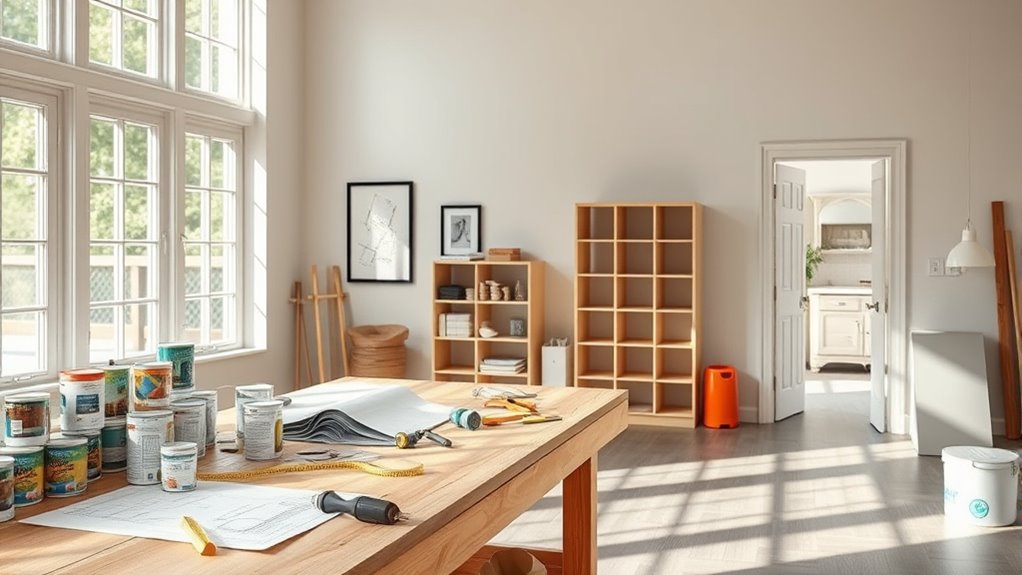
Before construction begins, you need to clear and protect your space to guarantee the work proceeds smoothly. Start by removing furniture, decor, and personal items from the work area to create ample space for contractors and materials. Perform a thorough space clearing to eliminate clutter and hazards. Next, prioritize safety precautions by covering floors with protective sheeting, securing loose wires, and shutting off utilities if necessary. Clear pathways to ensure easy access and prevent accidents. If needed, set up barriers or signage to keep pets and family members safe during construction. Taking these steps minimizes interruptions, keeps everyone safe, and helps your project stay on schedule. Proper preparation of your space is essential for a smooth, efficient construction process. Additionally, assessing the current layout can help identify potential constraints and ensure the space is optimized for your renovation needs.
Monitor Progress and Adjust Plans as Needed
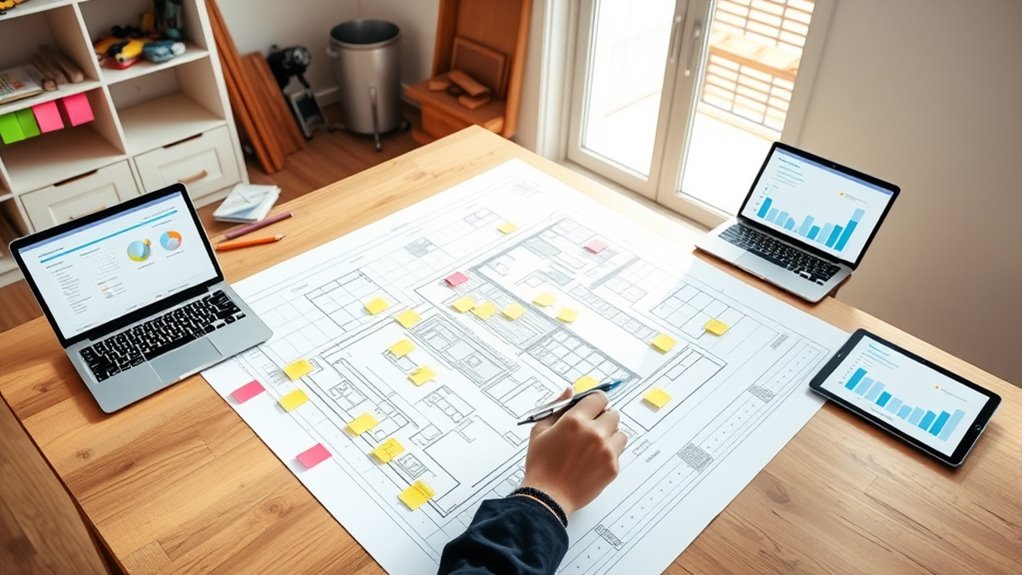
As your project unfolds, it’s important to regularly check your progress to stay on track. Be ready to adapt your schedule and plans when unexpected issues arise. Staying flexible guarantees you can handle changes smoothly and keep your project moving forward. Additionally, assessing your project’s technical requirements ensures that your equipment and setup meet the necessary standards for quality and performance.
Regular Progress Checks
How often should you check your progress during a home project? Regular progress checks are essential for effective progress tracking. Aim to review your work weekly or after completing key tasks. This keeps you aware of your timeline and helps spot issues early. During these check-ins, celebrate milestones to keep motivation high—recognizing small wins encourages continued effort. If you notice delays or problems, adjust your plans promptly to stay on schedule. Consistent evaluations prevent surprises later and ensure your project remains aligned with your goals. Remember, these regular progress checks aren’t about micromanaging but about maintaining momentum and making informed decisions. Additionally, incorporating quality assurance principles can help identify potential issues before they escalate. By staying proactive, you can keep your project on track and enjoy the satisfaction of steady advancement.
Flexible Scheduling Strategies
Staying flexible with your schedule allows you to adapt when unexpected delays or obstacles arise. Effective time management involves regularly monitoring your progress and being ready to shift tasks if needed. Incorporate contingency planning by building buffer days into your timeline, so minor setbacks don’t derail your entire project. Keep a close eye on your schedule, and if you notice tasks falling behind, adjust deadlines or reallocate resources accordingly. Flexibility helps you maintain momentum without feeling overwhelmed. Remember, rigid plans can cause stress, but adaptable strategies keep your project moving smoothly. By staying proactive and open to adjustments, you ensure your project stays on track and completes successfully, even if unforeseen circumstances occur. Keeping an eye on the project timeline can help you identify potential issues early and make necessary adjustments.
Adapt to Unexpected Changes
Monitoring your progress regularly allows you to catch issues early and make timely adjustments. Unexpected delays are common, whether due to weather, resource shortages, or supplier issues. When you notice delays in deliveries or quality concerns, don’t hesitate to revisit your plan. Flexibility is key—adjust your timeline, reorder materials, or find alternative suppliers if needed. Keep communication open with your team and suppliers to stay informed about any potential setbacks. Being proactive helps you minimize disruptions and stay on track. Regular check-ins enable you to respond quickly to unforeseen circumstances, preventing small issues from becoming major problems. Additionally, staying informed about sustainable practices can help you adapt your project to eco-friendly standards and materials. By staying vigilant and adaptable, you’ll ensure your project moves forward smoothly, despite any unexpected changes.
Finalize the Project and Enjoy Your New Space
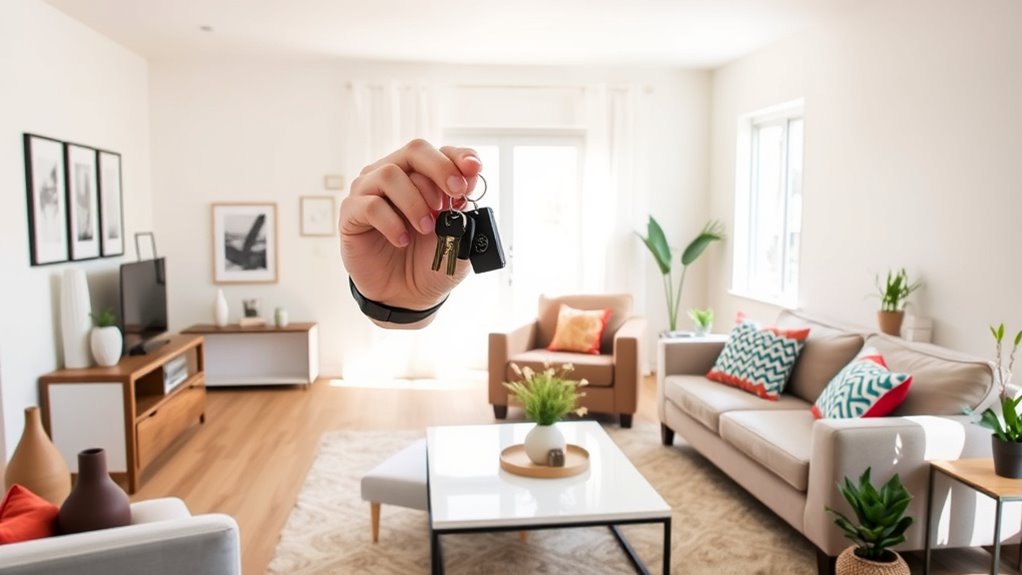
Once all the planning, budgeting, and construction are complete, it’s time to finalize your project and enjoy your new space. Start by arranging decorating ideas that reflect your style and make the area feel inviting. Consider adding personal touches, like artwork or plants, to create a cozy atmosphere. Before settling in, review maintenance tips to keep your space in top shape—this could include routine cleaning, checking for wear and tear, or adjusting fixtures. Take the time to organize and declutter, ensuring everything is functional and beautiful. Celebrating this milestone helps you appreciate your hard work. Additionally, you might want to confirm retail store hours to purchase any finishing touches or supplies needed for your space. Now, you can truly relax and enjoy your fresh, personalized space, knowing you’ve created a comfortable environment tailored to your needs.
Frequently Asked Questions
How Do I Prioritize Tasks Within My Home Project?
Did you know that proper task sequencing can reduce project time by up to 30%? First, list all tasks and identify dependencies to determine which must be done first. Then, allocate your resources wisely, focusing on high-priority tasks. Break larger tasks into smaller steps and set deadlines. This approach helps you stay organized, guarantees smooth workflow, and keeps your project on track from start to finish.
What Permits or Approvals Are Necessary Before Starting?
Before you start your home project, check if you need permits or approvals. You’ll likely need to adhere to local building codes and zoning regulations, which vary by area. Visit your city or county’s planning department website or contact them directly to find out what permits are required. Securing these guarantees your project meets legal standards and avoids costly fines or delays. Always obtain necessary approvals before breaking ground.
How Can I Ensure Safety During the Project?
To guarantee safety during your project, start by choosing the right tools and sourcing quality materials. Always wear protective gear like goggles, gloves, and masks. Keep your workspace organized and clear of hazards. Follow manufacturer instructions for tools and materials, and don’t rush—take your time. Regularly inspect your tools for damage and replace any that are unsafe. Staying attentive and prepared keeps you safe throughout your home project.
What Are Common Pitfalls to Avoid in Home Projects?
You should watch out for common pitfalls like overspending and poor planning. Avoid rushing into decorating ideas without a clear budget plan, which can cause stress and delays. Make sure to set realistic goals and allocate funds wisely. Also, don’t ignore measuring spaces properly or skipping permits. Staying organized and sticking to your plan helps you prevent mistakes, ensuring your project stays on track and within budget.
How Do I Handle Unexpected Delays or Issues?
When unexpected delays or issues arise, stay calm and communicate openly with your contractor. Discuss potential solutions and adjust your budget accordingly to accommodate additional costs. Keep a flexible mindset, and document any changes to avoid misunderstandings. Regular updates from your contractor help you stay informed and manage expectations. By maintaining clear communication and making timely budget adjustments, you can navigate surprises more smoothly and keep your project on track.
Conclusion
Now that you have a solid plan in place, you’re ready to tackle your home project head-on. Remember, Rome wasn’t built in a day, so stay patient and flexible along the way. Keep your goals clear, adapt when needed, and enjoy the process as your dream space comes to life. With careful planning and persistence, you’ll be surprised how smoothly everything falls into place. Your perfect home is just around the corner!

